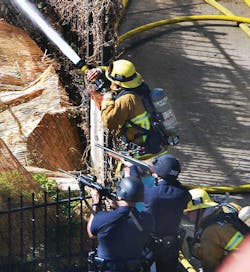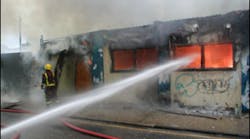The 'Omega Plan' for Firefighter Safety at Shooting Scenes
In recent months, firefighters have been called to a rash of shooting incidents involving other firefighters. The West Webster, N.Y. incident, where firefighters were ambushed by a gunman, is not the first time, and, sadly, will not be the last. Every member of an engine, truck or rescue company has a defined job. No National Fire Protection Agency manual has ever described part of any firefighter's job to be on the lookout for a deranged gunman. Thankfully, these events are very rare, but when they happen, the loss of life is high. There are some steps you can take to avoid being a casualty.
I named these incidents the "Omega Plan" after the Alpha and the Omega (the beginning and the end) as defined in the Bible. My definition of the Omega plan is any man or woman who has decided to wipe their existence off the planet. I will use the term active shooter in place of the Omega Plan, but there is one critical difference between the two terms. An active shooter is just randomly shooting. An Omega Plan is a more intricate and intimate plan on the part of the suspect. Typically, it starts with the killing of their family and pets. The plan then is to burn down their home and all their possessions to leaving no trace. The final act of the suspect is to go out in a blaze of glory, killing anyone they can and then themselves. If you get lucky, the suspect kills himself before your arrival.
Since the Columbine massacre, law enforcement has changed tactics to engage the active shooter suspects immediately instead of waiting on SWAT. It started as patrol officers forming four-man contact teams, but the debate now centers on the possibility of not waiting for four officers and going after the shooter with one or two officers. Some departments even equip their patrol officers with rifles, ballistic shields, heavy armor and helmets to make a rapid assault on the shooter(s).
Dispatch Law Enforcement To Fire Calls
You may feel helpless to prevent being a victim of an Omega Plan, but there are a number of steps that can be taken to mitigate the loss of life of responding firefighters. The first step is to have law enforcement dispatch Code 3 on every reported structure fire at the same time the fire department is dispatched. Since officers are in the field, they will typically beat the fire department to the scene. In an active shooter situation, it is best that law enforcement arrive first. Past experience with active shooters inside buildings have shown that most will commit suicide as the police approach. If not, they will engage the officers as the police officers pose the biggest threat to stopping them. Let the police know their role is to protect the firefighters from an active shooter, but most likely they will then morph into traditional roles like directing traffic and blocking LDH supply lines. Obviously, the vast majority of structure fires will just be structure fires. Police officers are notorious for parking directly in front of the burning structure, which will cause problems. Train with your police officers so they know where to park so they don't block the parking areas of the first-in truck and engine company.
Another critical part of the equation is to have law enforcement being able to talk directly to the responding fire apparatus. If the information has to go from a police officer to a police dispatcher to a fire dispatcher, and then to the responding fire apparatus, time is lost and the message can be inadvertently changed by the time it reaches the fire apparatus. If you make direct communication standard operating procedures during all structure fires, not only do you work out the kinks in the flow of information, but should you be rolling up on an ambush, everyone should be skilled in correct communications. While everyone across the country has supposed to have gone to plain language, police communication tends to be less formal that fire department communication. Both entities need to practice talking to each other so the difference in communications is known. A police officer will have no idea what a Mayday is. Every cop in the country knows what assist officers means.
For agencies with computer aided dispatch (CAD), the fire department should have access to the same hazard flags on addresses that the police department has on their mobile data computer. Police officers routinely add CAD information on addresses where suspects that are a threat to law enforcement reside. A fire officer on a responding fire apparatus could see this information and do a similar evaluation of conditions like they would roll up on a hazmat incident. Take a few seconds to look for any clues of an active shooter at a scene like multiple bodies in the yard or even cars on fire that weren't parked close enough to have ignited from exposure to the structure fire.
Treatment Of Multiple Victims
Evaluate your trauma treatment capabilities. Can you rapidly stop the bleeding on three to five patients? Law enforcement agencies across the country are moving towards small trauma kits containing a few items to treat gunshot wounds. Stopping bleeding trumps airway control and breathing in gunshot wounds. Dr. Alex Eastman, the Dallas Police Medical Director, Dallas Police SWAT doctor, and an emergency room doctor for Parkland Hospital, the county hospital in Dallas, put together a kit with Tactical Medical Resources that has an S.O.F. tourniquet, OLAES bandage, and a Quick Clot bandage that will treat any gunshot wound. Police officers can be trained in about an hour on how to use all the items in the kit and most have never had any formal medical training. The items can be self-administered if needed. The kits are under $100 dollars. With the number of active shooter incidents in the country, the kits would become a force multiplier if each apparatus had a kit for each crew member so they could each treat their own patient until sufficient medical resources arrive. A typical ambulance does not carry these items, but they are far superior to anything carried in the ambulance in stopping hemorrhaging gunshot wounds and sucking chest wounds. Some progressive departments have started carrying the S.O.F., C.A.T. or Israeli tourniquets. These items have been repeatedly battle tested and it has been found that compartmentalization syndrome doesn't start for hours, so the application of a tourniquet does no harm to the patient.
Responder Safety Ideas
Now that the preventative measures have been addressed, what do you do if you are caught in the middle of an active shooter implementing his Omega Plan? Flee, seek cover, or concealment immediately in that order. Don't vapor lock, keep thinking of a safe way out of the shooter's path. Cover simply defined is something that will stop bullets. Concealment doesn't stop bullets, but obscures your movements. If your crew is still in the apparatus, go in whatever direction necessary to get away from the shooter as fast as possible. Don't worry about damage to the fire apparatus. Run over anything other than innocent civilians that you have to so you can get away. If possible, pick up civilians to evacuate them from the area. If you are stuck and can't move the apparatus, get between the most solid object on the apparatus and the shooter. A diesel engine block will stop most rounds. An even better place of cover is the water tank. Bullets rapidly loose velocity and only travel a few feet through water. Consider cutting the stems of all the tires to lower the apparatus. Bullets that hit the ground don't bounce up into the air. In most cases, the bullet will continue along a path very low to the ground.
Don't put yourself in a position that you can't flee if the shooter comes at you. As soon as you are behind cover start looking for escape routes that have plenty of cover opportunities like large trees or brick walls. If the need arises where you must flee from your position, do so with the aid of concealment. The military uses smoke grenades, which aren't carried on fire apparatus and most police cars. However, a dry chemical fire extinguisher discharged in a tight up and down pattern four to six feet off the ground creates exceptional concealment. The powder hangs in the air better than military smoke. Wind will disperse smoke and dry chemical extinguishers in the same manner.
In the end, there is no perfect solution for surviving an Omega plan active shooter incident. There are some actions you can take to improve your chance of surviving the incident. Practice them. We do Mayday drills on a regular basis, why not get with your police department and practice an active shooter incident? The police can provide a bad guy armed with simunition rounds. Set a fire in your burn house and have a gunman. See how everyone reacts, then critique their actions. You may develop additional defensive tactics that can be shared with other fire departments across the country.
Recent incidents where firefighters encountered violence during responses:
- Calif. Fire Truck Hit by Bullets in Shootout Crossfire
- Kan. Man Charged With Trying to Kill Responders
- Conn. Firefighters Encounter Possible Gunman at Fire
MICHAEL J. MAGIERA is a police lieutenant and a volunteer firefighter in Texas.








